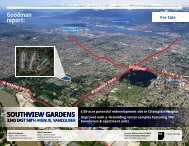Canada
MER-Canada-2016
MER-Canada-2016
You also want an ePaper? Increase the reach of your titles
YUMPU automatically turns print PDFs into web optimized ePapers that Google loves.
EXECUTIVE SUMMARY<br />
and enforcement program, but needs to further develop its sector-specific expertise and increase the<br />
intensity of supervision of DNFBPs, particularly in the real estate sector and with respect to DPMS,<br />
commensurate with the risks identified in the NRA.<br />
32. There are good market entry controls in place to prevent criminals and their associates<br />
from owning or controlling FIs and most DNFBPs. There are, however, no controls for DPMS, and<br />
fitness and probity controls at the provincial level are not conducted on an ongoing basis<br />
(i.e. including after-market entry).<br />
33. Supervisors appear generally effective. Remedial actions are effectively used and have been<br />
extensively applied by supervisors but the sanctioning regime for breaches of the Proceeds of Crime<br />
(Money Laundering) and Terrorist Financing Act (the PCMLTFA) has not been applied in a<br />
proportionate and/or sufficiently dissuasive manner. Supervisors have demonstrated that their<br />
actions have largely had a positive effect on compliance by FIs and some categories of DNFBPs. They<br />
have increased guidance and feedback to REs in recent years but further efforts are necessary,<br />
particularly with regard to the DNFBP sector. The exclusion of most of the legal professions (legal<br />
counsels, legal firms and Quebec notaries) from AML/CFT supervision has a negative impact on the<br />
effectiveness of the supervisory regime as a whole.<br />
Transparency of Legal Persons and Arrangements (Chapter 7 - IO5; R. 24-25)<br />
34. Canadian legal entities and legal arrangements are at a high risk of misuse for ML/TF<br />
purposes and that risk is not mitigated. This is notably the case with respect to nominee<br />
shareholding arrangements, which are commonly used across <strong>Canada</strong> and pose real obstacles for<br />
LEAs.<br />
35. Basic information on legal persons is publicly available, but beneficial ownership<br />
information is more difficult to obtain. Some information is collected by FIs and to a limited extent<br />
DNFBPs, the tax authorities and legal entities themselves, but is neither verified nor comprehensive<br />
in all cases. LEAs have the necessary powers to obtain that information, but the process is lengthy.<br />
Information exchange between LEAs and the CRA is also limited by stringent legal requirements.<br />
36. The authorities have insufficient access to information related to trusts. Some information<br />
is collected by the CRA as well as by FIs providing financial services, but that information is not<br />
verified, does not always pertain to the beneficial owner, and is even more difficult to obtain than in<br />
the case of legal entities.<br />
37. LEAs have successfully identified the beneficial owners in limited instances only. Despite<br />
corporate vehicles and trusts posing a major ML and TF risk in <strong>Canada</strong>, LEAs do not investigate many<br />
cases in which legal entities or trusts played a prominent role or that involved complex corporate<br />
elements or foreign ownership or control aspects.<br />
International Cooperation (Chapter 8 - IO2; R. 36-40)<br />
38. range of mutual legal assistance (MLA) provided by <strong>Canada</strong> is generally broad, and<br />
countries provided—through the FATF—largely positive feedback regarding the responsiveness and<br />
8<br />
Anti-money laundering and counter-terrorist financing measures in <strong>Canada</strong> - 2016 © FATF and APG 2016




